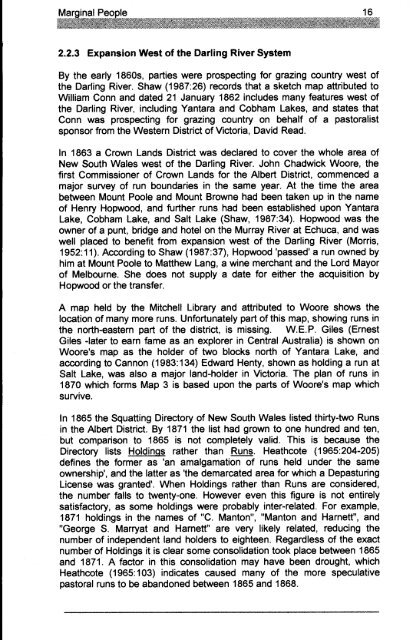Adec Preview Generated PDF File - The Sydney eScholarship ...
Adec Preview Generated PDF File - The Sydney eScholarship ...
Adec Preview Generated PDF File - The Sydney eScholarship ...
Create successful ePaper yourself
Turn your PDF publications into a flip-book with our unique Google optimized e-Paper software.
2.2.3 Expansion West of the Darling River System<br />
By the early 1860s, parties were prospecting for grazing country west of<br />
the Darling River. Shaw (1987:26) records that a sketch map attributed to<br />
William Conn and dated 21 January 1862 includes many features west of<br />
the Darling River, including Yantara and Cobham Lakes, and states that<br />
Conn was prospecting for grazing country on behalf of a pastoralist<br />
sponsor from the Western District of Victoria, David Read.<br />
In 1863 a Crown Lands District was declared to cover the whole area of<br />
New South Wales west of the Darling River. John Chadwick Woore, the<br />
first Commissioner of Crown Lands for the Albert District, commenced a<br />
major survey of run boundaries in the same year. At the time the area<br />
between Mount Poole and Mount Browne had been taken up in the name<br />
of Henry Hopwood, and further runs had been established upon Yantara<br />
Lake, Cobham Lake, and Salt Lake (Shaw, 1987:34). Hopwood was the<br />
owner of a punt, bridge and hotel on the Murray River at Echuca, and was<br />
well placed to benefit from expansion west of the Darling River (Morris,<br />
1952:11). According to Shaw (1987:37), Hopwood 'passed' a run owned by<br />
him at Mount Poole to Matthew Lang, a wine merchant and the Lord Mayor<br />
of Melbourne. She does not supply a date for either the acquisition by<br />
Hopwood or the transfer.<br />
A map held by the Mitchell Library and attributed to Woore shows the<br />
location of many more runs. Unfortunately part of this map, showing runs in<br />
the north-eastern part of the district, is missing. W.E.P. Giles (Ernest<br />
Giles -later to earn fame as an explorer in Central Australia) is shown on<br />
Woore's map as the holder of two blocks north of Yantara Lake, and<br />
according to Cannon (1983:134) Edward Henty, shown as holding a run at<br />
Salt Lake, was also a major land-holder in Victoria. <strong>The</strong> plan of runs in<br />
1870 which forms Map 3 is based upon the parts of Woore's map which<br />
survive.<br />
In 1865 the Squatting Directory of New South Wales listed thirty-two Runs<br />
in the Albert District. By 1871 the list had grown to one hundred and ten,<br />
but comparison to 1865 is not completely valid. This is because the<br />
Directory lists Holdings rather than Runs. Heathcote (1965:204-205)<br />
defines the former as 'an amalgamation of runs held under the same<br />
ownership', and the latter as 'the demarcated area for which a Depasturing<br />
License was granted'. When Holdings rather than Runs are considered,<br />
the number falls to twenty-one. However even this figure is not entirely<br />
satisfactory, as some holdings were probably inter-related. For example,<br />
1871 holdings in the names of "C. Manton", "Manton and Harnett", and<br />
"George S. Marryat and Harnett" are very likely related, reducing the<br />
number of independent land holders to eighteen. Regardless of the exact<br />
number of Holdings it is clear some consolidation took place between 1865<br />
and 1871. A factor in this consolidation may have been drought. which<br />
Heathcote (1965: 103) indicates caused many of the more speculative<br />
pastoral runs to be abandoned between 1865 and 1868.




